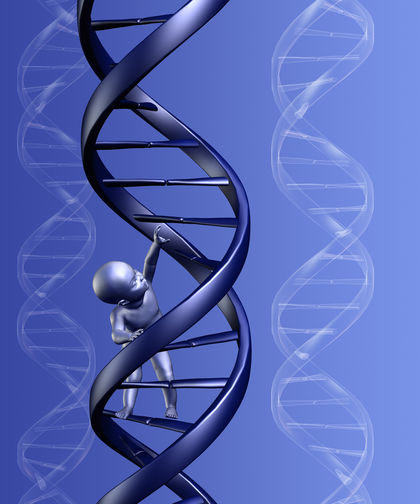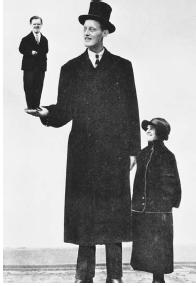Heredity - Real-life applications

Population Genetics
Studies in heredity and genetics can be applied not only to an individual or family but also to a whole population. By studying the gene pool (the sum of all the genes shared by a population) for a given group, scientists working in the field of population genetics seek to explain and understand specific characteristics of that group. Among the phenomena of interest to population geneticists is genetic drift, a natural mechanism for genetic change in which specific traits coded in alleles change by chance over time, especially in small populations, as when organisms are isolated on an island. If two groups of the same species are separated for a long time, genetic drift may lead even to the formation of distinct species from what once was a single life-form. When the Colorado River cut open the Grand Canyon, it separated groups of squirrels that lived in the high-altitude pine forest. Over time, populations ceased to interbreed, and today the Kaibab squirrel of the north rim and the Abert squirrel of the south are different species, no more capable of interbreeding than humans and apes.
Where humans are concerned, population genetics can aid, for instance, in the study of genetic disorders. As discussed in Mutation, certain groups are susceptible to particular conditions: thus, cystic fibrosis is most common among people of northern European descent, sickle cell anemia among those of African and Mediterranean ancestry, and Tay-Sachs disease among Ashkenazim, or Jews whose ancestors lived in eastern Europe. Studies in population genetics also can supply information about prehistoric events. As a result of studying the DNA in fossil records, for example, some scientists have reached the conclusion that the migration

Genetic Disorders
There are several thousand genetic disorders, which can be classified into one of several groups: autosomal dominant disorders, which are transmitted by genes inherited from only one parent; autosomal recessive disorders, which are transmitted by genes inherited from both parents; sex-linked disorders, or ones associated with the X (female) and Y (male) chromosome; and multifactorial genetic disorders. If one parent has an autosomal dominant disorder, the off-spring have a 50% chance of inheriting that disease. Approximately 2,000 autosomal dominant disorders have been identified, among them Huntington disease, achondroplasia (a type of dwarfism), Marfan syndrome (extra-long limbs), polydactyly (extra toes or fingers), some forms of glaucoma (a vision disorder), and hypercholesterolemia (high levels of cholesterol in theblood).
The first two are discussed in Mutation. Marfan syndrome, or arachnodactyly ("spiderarms"), is historically significant because it isbelieved that Abraham Lincoln suffered fromthat condition. Some scientists even maintain that his case of Marfan, a disease sometimes accompanied by eye and heart problems, was so severe that he probably would have died six months or a year after the time of his actual death by assassination at age 56 in April 1865.
RECESSIVE GENE DISORDERS.
Just as a person has a 25% chance of inheriting two recessive alleles, so two parents who each have a recessive gene for a genetic disorder stand a 25% chance of conceiving a child with that disorder. Among the approximately 1,000 known recessive genetic disorders are cystic fibrosis, sickle cell anemia, Tay-Sachs disease, galactosemia, phenylketonuria, adenosine deaminase deficiency, growth hormone deficiency, Werner syndrome (juvenile muscular dystrophy), albinism (lack of skin pigment), and autism. Several of these conditions are discussed briefly elsewhere, and albinism is treated at length in Mutation. Note that all of the disorders mentioned earlier, in the context of population genetics, are recessive gene disorders. Phenylketonuria (see Metabolism) and galactosemia are examples of metabolic recessive gene disorders, in which a person's body is unable to carry out essential chemical reactions. For example, people with galactosemia lack an enzyme needed to metabolize galactose, a simple sugar that is found in lactose, or milk sugar. If they are given milk and other foods containing galactose early in life, they eventually will suffer mental retardation.
SEX-LINKED GENETIC DISORDERS.
Dominant sex-linked genetic disorders affect females, are usually fatal, and—fortunately—are rather rare. An example is Albright hereditary osteodystrophy, which brings with it seizures, mental retardation, and stunted growth. On the other hand, several recessive sex-linked genetic disorders are well known, though at least one of them, color blindness, is relatively harmless. Among the more dangerous varieties of these disorders, which are passed on to sons through their mothers, the best known is hemophilia, discussed in Noninfectious Diseases. Many recessive sex-linked genetic disorders affect the immune, muscular, and nervous systems and are typically fatal. An example is severe combined immune deficiency syndrome (SCID), which is characterized by a very poor ability to combat infection. The only known cure for SCID is bone marrow transplantation from a close relative. Short of a cure, patients may be forced to live enclosed in a large plastic bubble that protects them from germs in the air. From this sad fact derives the title of an early John Travolta movie, The Boy in the Plastic Bubble (1976), based on the true story of the SCID victim Tod Lubitch. (The ending, in which Travolta, as Tod, leaves his bubble and literally rides off into the sunset with his beautiful neighbor Gina, is more Hollywood fiction than fact. Lubitch actually died in his early teens, shortly after receiving a bone marrow transplant.)
MULTIFACTORIAL GENETIC DISORDERS.
Scientists often find it difficult to determine the relative roles of heredity and environment in certain medical disorders, and one way to answer this question is with statistical and twin studies. Identical and fraternal twins who have been raised in different and identical homes are evaluated for multifactorial genetic disorders. Multifactorial genetic disorders include medical conditions associated with diet and metabolism, among them obesity, diabetes, alcoholism, rickets, and high blood pressure. Other such multifactorial conditions are a tendency toward certain infectious diseases, such as measles, scarlet fever, and tuberculosis; schizophrenia and some other psychological illnesses; clubfoot and cleft lip; and various forms of cancer. The tendency of a particular person to be susceptible to any one of these disorders is a function of that person's genetic makeup, as well as environmental factors.
Breeding within the Family
If there is one thing that most people know about heredity and breeding, it is that a person should never marry or conceive offspring with close relatives. Aside from moral restrictions, there is the fear of the genetic defects that would result from close interbreeding. How close is too close? Certainly, first cousins are off-limits as potential mates, though second or third cousins (people who share the same great-grandparents and the same great-great-grandparents, respectively) are probably far enough apart. Hence, the phrase "kissin' cousins," meaning a relative who is a distant enough to be considered a potential partner.
What kind of defects? Hemophilia, mentioned earlier, is popularly associated with royalty because several members of European ruling houses around the turn of the nineteenth century had it. Common wisdom maintains that the tendency toward the disease resulted from the fact that royalty were apt to marry close relatives. In fact, hemophilia has nothing to do with royalty per se and certainly bears no relation to marriages between close relatives. Research findings gathered over the course of more than three decades, beginning in 1965, indicate that many views about first cousins marrying may be more a matter of tradition than of scientific fact. According to information published in the Journal of Genetic Counseling and reported in the New York Times in April 2002, first cousins who have children together face only a slightly higher risk than parents who are completely unrelated. For example, within the population as a whole, the risk that a child will be born with a serious defect, such as cystic fibrosis, is 3-4%, while first cousins who conceive a child typically add another 1.7-2.8 percentage points of risk. Although this represents nearly double the risk, it is still a very small factor.
Researchers were quick to point out that mating should not take place between persons more closely related than first cousins. According to Denise Grady in the New York Times, "The report made a point of saying that the term 'incest' should not be applied to cousins, but only to sexual relations between siblings or between parents and children." First cousins, on the other hand, are a quite different matter, a fact borne out by the long history of people who married their first cousins. One example was Charles Darwin, who fathered many healthy children with his cousin, Emma Wedgwood.
WHERE TO LEARN MORE
Ackerman, Jennifer. Chance in the House of Fate: A Natural History of Heredity. Boston: Houghton Mifflin, 2001.
Center for the Study of Multiple Birth (Web site). <http://www.multiplebirth.com/> .
Clark, William R., and Michael Grunstein. Are We Hardwired?: The Role of Genes in Human Behavior. New York: Oxford University Press, 2000.
The Gene School (Web site). <http://library.thinkquest.org/19037/heredity.html> .
Genetic Disorders (Web site). <http://dir.yahoo.com/Health/Diseases_and_Conditions/Genetic_Disorders/> .
Grady, Denise. " Few Risks Seen to the Children of First Cousins ." New York Times, April 4, 2002.
Hawley, R. Scott, and Catherine A. Mori. The Human Genome: A User's Guide. San Diego: Academic Press, 1999.
Heredity and Genetics. The Biology Project at the University of Arizona (Web site). <http://student.biology.arizona.edu/sciconn/heredity/worksheet_heredity.html> .
Reproduction and Heredity (Web site). <http://www.usoe.k12.ut.us/curr/science/sciber00/7th/genetics/sciber/intro.htm> .
Ridley, Matt. Genome: The Autobiography of a Species in 23 Chapters. New York: HarperCollins, 1999.
Wynbrandt, James, and Mark D. Ludman. The Encyclopedia of Genetic Disorders and Birth Defects. New York: Facts on File, 2000.
Comment about this article, ask questions, or add new information about this topic: